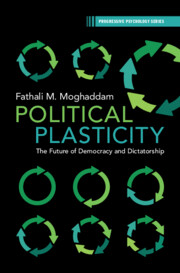Book contents
- Political Plasticity
- The Progressive Psychology Book Series
- Political Plasticity
- Copyright page
- Dedication
- Contents
- Figures
- Preface
- Acknowledgments
- Chapter 1 Political Plasticity, the Key to Understanding the Future of Democracy and Dictatorship
- Chapter 2 Hardwiring inside and outside People
- Part I Political Plasticity and Behavioral Continuity
- Part II Change Agents, in Theory and Practice
- Chapter 8 Revolutions and Political Plasticity
- Chapter 9 War as Transformative
- Chapter 10 Technology Forces Change
- Chapter 11 Globalization and Deglobalization
- Part III Looking Ahead
- Notes
- References
- Index
Chapter 8 - Revolutions and Political Plasticity
from Part II - Change Agents, in Theory and Practice
Published online by Cambridge University Press: 15 January 2023
- Political Plasticity
- The Progressive Psychology Book Series
- Political Plasticity
- Copyright page
- Dedication
- Contents
- Figures
- Preface
- Acknowledgments
- Chapter 1 Political Plasticity, the Key to Understanding the Future of Democracy and Dictatorship
- Chapter 2 Hardwiring inside and outside People
- Part I Political Plasticity and Behavioral Continuity
- Part II Change Agents, in Theory and Practice
- Chapter 8 Revolutions and Political Plasticity
- Chapter 9 War as Transformative
- Chapter 10 Technology Forces Change
- Chapter 11 Globalization and Deglobalization
- Part III Looking Ahead
- Notes
- References
- Index
Summary
Almost all psychological research relevant to revolutions focuses on the conditions in which collective action takes place to topple the ruling regime; almost no attention has been given to what happens after revolutions. Psychologists have homed in on relative deprivation, perceived injustice, identity processes, morality, and related factors as important in collection mobilization. But no serious attention has been given to the question of why after regime change almost all revolutionary governments fail to change mass behavior in line with their revolutionary ideals. The concept of political plasticity is applied in this chapter to explain this failure. Change at the macropolitical and macroeconomic levels can come overnight with the signing of a radical new constitution, but change of actual behavior in line with the ideals of the new constitution takes a much longer time, if it is possible at all. An example is the efforts of the Soviet communists to change behavior in line with their economic and political ideals of collective ownership and collective motivation.
Keywords
- Type
- Chapter
- Information
- Political PlasticityThe Future of Democracy and Dictatorship, pp. 87 - 100Publisher: Cambridge University PressPrint publication year: 2023



